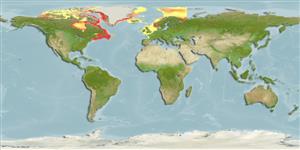Environment: milieu / climate zone / depth range / distribution range
Ökologie
seewasser demersal; tiefenbereich 30 - 400 m (Ref. 58496), usually 60 - 200 m (Ref. 4701). Polar; -2°C - 3°C (Ref. 4701); 83°N - 42°N, 136°W - 69°E
Arctic, Northwest to Northeast Atlantic: Barents Sea to Franz Josef Land, Spitzbergen, Greenland, and south along North American coast to Massachusetts (Ref. 48811); including Iceland and Norway (Ref. 4701); Canadian Arctic to Hudson Bay in Canada (Ref. 7251).
Size / Gewicht / Alter
Maturity: Lm ? range ? - ? cm
Max length : 13.2 cm NG Männchen/unbestimmt; (Ref. 58426)
Inhabits stony bottoms (Ref. 4701). Benthic species. Feeds on crustaceans, oikopleura and fishes (Ref. 58426).
Life cycle and mating behavior
Maturities | Fortpflanzung | Spawnings | Egg(s) | Fecundities | Larven
Stein, D.L., 1986. Cyclopteridae. p. 1269-1274. In P.J.P. Whitehead, M.-L. Bauchot, J.-C. Hureau, J. Nielsen and E. Tortonese (eds.) Fishes of the North-eastern Atlantic and the Mediterranean. UNESCO, Paris. Vol. III. (Ref. 4701)
IUCN Rote Liste Status (Ref. 130435)
Bedrohung für Menschen
Harmless
Nutzung durch Menschen
Tools
Zusatzinformationen
Download XML
Internet Quellen
Estimates based on models
Preferred temperature (Ref.
123201): -1 - 7.1, mean 0.8 °C (based on 559 cells).
Phylogenetic diversity index (Ref.
82804): PD
50 = 0.5000 [Uniqueness, from 0.5 = low to 2.0 = high].
Bayesian length-weight: a=0.02089 (0.00774 - 0.05639), b=3.03 (2.79 - 3.27), in cm total length, based on LWR estimates for this (Sub)family-body shape (Ref.
93245).
Trophic level (Ref.
69278): 3.2 ±0.40 se; based on food items.
Widerstandsfähigkeit (Ref.
120179): mittel, Verdopplung der Population dauert 1,4 - 4,4 Jahre. (Assuming tmax=3-10).
Fishing Vulnerability (Ref.
59153): Low vulnerability (10 of 100).
